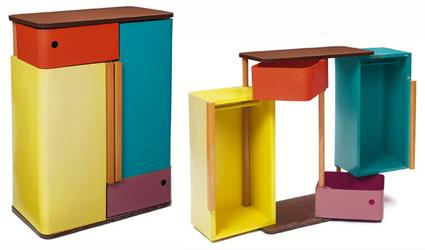
Molded Plywood Week continues here at Daddy Types, but I should probably just call it Orelandy Week after the mid-century design afficionado, eBay shark, and daddy type who's forgotten more about modern kids design than I've ever known.
For example: the Swingline Group was designed for the Fernwood Furniture Company by Chicago architect and industrial designer Henry Glass. His drawings for the brightly colored, highly modular, molded ply and masonite pieces are dated from 1949, and they went into production briefly in the early 1950's. That puts them equidistant from the riotous color bombs of the Bauhaus and the swingin' Verner Panton, Joe Colombo, Eero Aarnio 60's-into-70's.
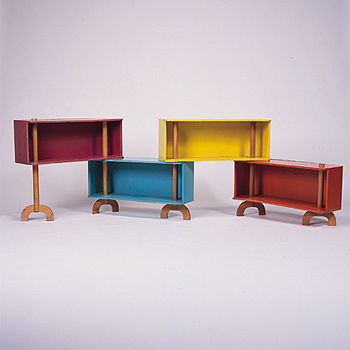
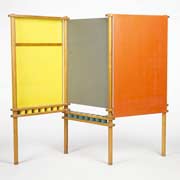
I had no idea about Glass, Swingline, or Fernwood. Pieces like this easel/room divider, and even that movable book case, could almost exist in the Eames-dominated 50's of my mind, but the lowboy dresser and the most stunning designs--the cut-n-molded ply desk [but what's up with the fugly kitchen chair?] and that awesome, swing-apart wardrobe--are easily a decade or two ahead of their time. Three, if you count Memphis, four if you count the US mainstreaming of Ikea.
So it should surprise no one that the pieces didn't stay in production too long. A couple have turned up at the modern furniture design auctions, and Chicago's Architech Gallery seems to have locked up their hometown boy's estate, which contained his archive and some leftover pieces.
With a thin, underappreciated market, a serious shortage of available pieces, and a place in design history that's still to be fully written, it's not easy to say what Glass's work should sell for. There's not enough market data like with, say Eames or Knoll, so the auctions' $3k, $5k, $7k prices and estimates aren't more than educated guesses. Keep your eyes peeled, though. In a midwest antique mall, colors like these should be hard to miss.
The World of Henry Glass, Mid-Century Modernist [Architech Gallery]
Henry Glass designs, including the lowboy and the divider [architonic.com]

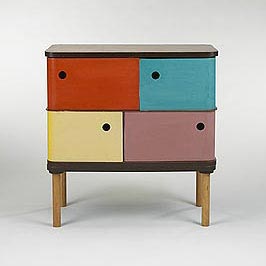
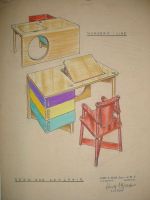
ok, heres a mid century modern question... whats up with the highgirl, lowboy thing? is there such a thing as a highboy? or a lowgirl? what differentiates them? just wonderin'.
[Swingline/Fernwood actually called it a dresser; I called it a lowboy because that's what the shape reminded me of: a low dresser raised up on legs. Highboy or tallboy is either a chest-on-chest or a lowboy with another dresser on top. They're originally 17th-18th c. furniture terms, i.e, Chippendale, Queene Anne, etc. -ed.]